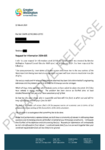Response to LGOIMA request 2024-035 22 March 2024
Search in document library
Request for information:
"The announcement by Tranz Metro of further service restrictions due to the new sections of the Wairarapa track having been laid on average 4mm narrower will have come as unwelcome news for all of us.
The various media and PR releases note that the new track has been laid within KiwiRail's engineering tolerances and the problem seems to lie with the Wairarapa service carriages.
Which all begs many questions which nobody seems to have asked let alone answered. Or if they have nobody is saying anything! The problem has been known to KiwiRail since at least October/November last year and I have anecdotal proof of that.
So how has this come about, who is responsible and how will it be fixed, at what cost and will the long-suffering tax and ratepayer foot the bill?
The lack of a reliable rail service that is fit for purpose carries an economic cost in terms of lost productivity to say nothing of the frustrations of the daily commuter.
The situation is so outrageous that something has to be done.
As the local parliamentary representatives you both have a community of interest in addressing these questions and demanding answers of KiwiRail on behalf of your Wairarapa constituents. I anticipate that KiwiRail will be defensive and butt covering like fury. Requests for information will undoubtedly be met with obfuscation if not refusal. I would anticipate that if you two can work together then your combined requests/demands are less likely to be ignored.
The questions I would see follow these themes:
- Do we have competence at governance/management level at KiwiRail? The publicly available information states that the NZ rail standard gauge is 1068mm (the old 3 foot 6 inches). Publicly released information from KiwiRail that "the track has been laid 4mm narrower" would suggest, if not evidence, that there has been a fundamental failure from top to bottom of the organisation. Whether the track is within engineering tolerance is not the point. It is not within gauge such that it is fit for purpose. The trains cannot run at the intended speed.
- How did this occur?
- Was it a mistake? And if so what accountability is there for this mistake?
- If it is not a mistake was it not reasonably foreseeable that there would be a problem with old rolling stock and new rail sections of track if you lay sections narrower than the standard gauge?
- What investigation was undertaken as to the suitability of the existing rolling stock using track laid at a narrower gauge? And if not why was there no such investigation undertaken?
- Was the work involving the laying of the new track all done in-house by KiwiRail or contracted out?
- Who did the design work?
- What is their experience and qualifications?
- What was the scope of works?
- What was the specification for the new track? Especially the track - note not all track is not the same and there is a variation in specification of the steel - was this a cheap job?
- Who signed off on the design and contract work?
- Does the problem lie with (or rather the absence) of a skilled work force?
- Do we have supervisory competence of the workforce?
- On site who is responsible for supervision and what is the level of experience of the supervisors?
- Do the track laying gangs have permanent employment with KiwiRail? If not why not? What is the average experience of the KiwiRail track staff/gangers/supervisors etc? What is their pay rates?
- When and how was the work checked and pronounced within tolerance? Who signed this off?
- If the problem lies with one class of the carriages SE or SW which is it, what precisely is the issue/problem and how has this occurred? Again was the problem not foreseeable? See information below from Wikipedia. What we have on the Wairarapa line are old English carriages imported and refurbished at Hillside workshop Dunedin in 2006. The link to the full page is below - but in summary we have old redundant English rolling stock dropped on to old bogies. A cheap work around. We are all now the beneficiaries of that short sighted cost saving."
As noted in our response dated 13 March 2024 advising of the transfer of the request to KiwiRail, this letter is only to respond to the following question which we hold information on:
"If the problem lies with one class of the carriages SE or SW which is it, what precisely is the issue/problem and how has this occurred? Again was the problem not foreseeable?"